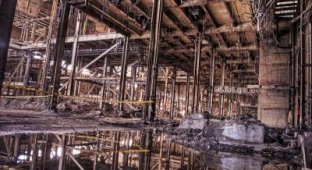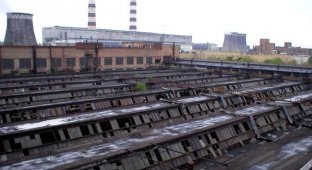Moscow Oil Refinery (28 photos)
The Moscow Oil Refinery is one of the leading enterprises in the domestic oil refining industry and the largest supplier of petroleum products to the market of the capital region. The plant occupies a leading position in the production of high-octane gasoline and environmentally friendly diesel fuels, and is also among the top five enterprises in terms of capacity utilization for deep oil refining.

Source: LJ/chistoprudov

1) In the mid-30s of the twentieth century, the government of the country decided to build an oil refinery near Moscow to supply the capital and region with motor fuel and bitumen.

2) The plant’s production complex includes 23 technological units and produces AI-80 gasoline; AI-92; AI-95, diesel fuel, jet fuel, bitumen, sulfur, various polymers and so on.

3) Installation of primary oil refining "ELOU-AVT-6". It performs atmospheric-vacuum distillation of crude oil and is designed to separate oil into its component parts according to their boiling points in order to obtain commercial petroleum products or their components.

4) During atmospheric distillation, oil is heated to a temperature of 360-370 ° C, at which the boiled-off fractions are distilled off, leaving fuel oil in the residue. Petroleum fractions produce various types of fuels (gasoline, jet and diesel engine fuels), raw materials for petrochemical synthesis (benzene, ethylbenzene, xylenes, ethylene, propylene, butadiene), solvents and more.

5)

6) The vacuum column is the heart of the installation. Further distillation of fuel oil is carried out under vacuum. The resulting material is used as a raw material for the production of oils, paraffin, bitumen, for cracking or can be used as liquid boiler fuel. The residue (concentrate, tar) after oxidation can be used as road and construction bitumen or as a component of boiler fuel.

7) Cylindrical heat exchangers.

8) Most petroleum refining processes occur at high temperatures, and heat exchangers serve to heat and cool the product.

9) Valves.

10) Various product lines leading to heat exchangers.

11) The productivity of such an installation is 6 million tons of oil per year.

12)

13) A significant increase in the consumption of petroleum products and increasingly stringent requirements for their quality have created the need for so-called secondary oil processing.

14) As a result of secondary processing, starting materials are obtained from oil for the production of the most important products: synthetic rubbers and fibers, plastics, surfactants, detergents, plasticizers, additives, dyes and many others.

15) Catalytic cracking unit G-43-107. Catalytic cracking is one of the most important processes that ensures deep oil refining to produce high-octane gasoline.

16) Combined installation for the production of MTBE (methyl tert-butyl ether).

17) Combined installation TAME (Tert amyl ethyl ether).

18) The work of MTBE and TAME allows the plant to produce high-octane motor gasoline within the framework of the program developed by the Moscow Government to reduce the harmful impact of motor vehicles on the environmental situation in Moscow.

19)

20)

21) It is impossible for an untrained person to understand the complex system of pipes, compressors and valves.

22) One of the control and monitoring points for the operation of oil refining plants.

23) Catalytic reforming unit L-35-11/300. With its help, commercial unleaded gasolines AI-92ek and AI-95ek are produced with improved environmental properties that meet European Euro-3 emission standards.

24) The same installation at night.

25) By order of the Moscow government, in 1993, construction began on Russia’s first polypropylene production complex with a capacity of 100 thousand tons per year.

26) The technological process for producing granulated polypropylene is a closed-cycle process using waste-free technology and is fully automated at all stages.

27) Polypropylene is intended for the production of injection molded, extrusion, blown products: pipes, fittings, sheets, tapes, films, packaging and nonwoven materials, fibers, monofilaments, film threads and other products for technical, household and medical purposes.

28) On the left is a G-43-107 catalytic cracking unit, and on the right is polypropylene granulation.























